 |
|

|
 |
TABLE of CONTENTS
 |
State invests $70 million in 13 new Corridors of Commerce projects |

One of the Corridors of Commerce projects announced by Gov. Mark Dayton and Commissioner Charlie Zelle Oct. 7 calls for an expansion to four lanes of Hwy 371 from Nisswa to Jenkins. Photo courtesy of District 3 |
Construction on 13 transportation projects will be accelerated thanks to $70 million in new investments into the Corridors of Commerce program, Gov. Mark Dayton and Commissioner Charlie Zelle announced Oct. 7.
The $70 million includes both existing Corridors of Commerce funds and cost savings MnDOT achieved on other projects.
The 13 new projects, and 14 other projects that previously received Corridors of Commerce funding, will strengthen the state’s transportation system by adding capacity and improving the movement of freight across Minnesota.
“These projects will reduce travel times, improve safety for Minnesota citizens, and help our businesses transport their products more efficiently,” said Dayton. “The number of projects from all over our state, which sought financing from this program, underscores the acute need for more transportation funding.”
The state has invested $331 million in the Corridors of Commerce initiative since November 2013.
Twelve of the projects will be funded with $25 million the governor and the Legislature provided in 2014 for Corridors of Commerce. The 13th project – an expansion to four lanes on Hwy 371 from Nisswa to Jenkins – was made possible by $45 million in cost savings at MnDOT. Funding for this $58 million project was provided through bid savings on the extension of Hwy 610 and other MnDOT efficiencies in the Corridors of Commerce program. MnDOT will begin construction on the project in 2016, two years earlier than planned.
“We have worked hard to be efficient and effective in determining where the money will serve Minnesota best,” Zelle said. “The $25 million will help advance selected projects to ensure they can be completed when additional funding becomes available. And the Hwy 371 project will provide better roads for businesses in that corridor as well as for the many Minnesotans who travel to that area for recreation.”
The new 2014 Corridors of Commerce projects are:
Greater Minnesota Projects
- Hwy 14 & Hwy 15 intersection – New Ulm ($700,000)
- Interstate 94 – St. Michael to Albertville ($1.4 million)
- Hwy 11 – Greenbush to Warroad ($500,000)
- Hwy 14 – Owatonna to Dodge Center ($7.3 million)
- Hwy 23 – New London to Paynesville ($800,000)
- Hwy 34 – Detroit Lakes to Becker CR 19 ($1.8 million)
- Hwy 371 – Nisswa to Jenkins (provides $45 million to $58 million project)
Twin Cities Metro Area
- Hwy 169 – Nine Mile Creek Bridge in Hopkins and Edina ($1.5 million)
- I-35W – Minnesota River Crossing between Burnsville and Bloomington ($5.5 million)
- I-35W – Northern Suburbs MnPASS in Arden Hills and Lino Lakes ($1.1 million)
- Hwy 65/Central Avenue in Minneapolis – Bridge deck replacement design ($1 million)
- I-94 – Between Minneapolis and St. Paul ($2 million)
- Snelling Avenue – St. Paul ($1.4 million)
For more information about these projects and the Corridors of Commerce program, see www.mndot.gov/corridorsofcommerce/. Click here to view a map of all 27 Corridors of Commerce projects. |
 |
|

|
 |
TABLE of CONTENTS
 |
Orange snowplows dominate Camp Ripley roads during snowplow operators training |
|
Maintenance supervisors and other staff trained more than 90 snowplow operators Sept. 15-26 at the Camp Ripley training facility near Little Falls. The training program, known as SPOT, is a two-week session that highlights a variety of safety measures, plowing techniques and best practices. Video produced by Rich Kemp |
|
 |
|

|
 |
TABLE of CONTENTS
 |
Steel replacing wood in guardrail posts to increase safety, save money |
|
By Sue Roe

MnDOT is replacing wooden posts in guardrails with steel posts to save costs and meet environmental standards. Dewayne Jones, Metro District, displays what a guardrail wooden and steel post look like before being installed into the ground. Photo by Roosevelt Johnson |
MnDOT Metro District maintenance crews spend a lot of time repairing guardrails. Guardrails protect motorists as they drive over bridges and past openings that could potentially take them into hazards such as water, ditches or opposing lanes of traffic.
Since guardrails can’t stop every kind of vehicle from running off the road, it’s important that they do their job as effectively as possible. And crews want to repair them quickly too, so the guardrails continue to do their part in providing safe roadways.
For years, wooden posts were standard use in guardrails, but hinged breakaway steel posts are increasingly being used in most guardrails for several reasons, according to Dewayne Jones, Metro District superintendent of attractive roadsides and safety features.
When guardrails get hit, it usually means the wooden posts are damaged and need replacement. Every 25 feet of guardrail has five posts. If a crash takes out five posts, it takes about 90 minutes to remove each wooden post, and that’s only “if everything goes OK,” maintenance crews are quick to add.
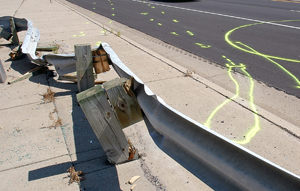
This is often what guardrails with wooden posts look like after a crash. The posts are damaged beyond repair, resulting in their replacement, which in this case can be time-consuming because they are installed in concrete. Steel posts have a breakaway hinge which fold over at ground level and can be easily replaced. Photo by David Gonzalez |
Jones said steel posts can be replaced faster than wooden posts because steel posts have a breakaway hinge that folds over at ground level, allowing repairs to be done above ground. A five-post hit with steel only takes about 15 minutes to replace each post.
This also means employees spend less time working near traffic, and lane closures are kept to a minimum. Specialized equipment and traffic control equipment costs are also reduced.
Maintenance crews generally don’t have to contact Gopher State One Call to locate utilities when repairing the steel posts because of the breakaway hinge. One Call can take up to 48 hours before a maintenance crew gets the OK to do the repair with wooden posts.
“Part of MnDOT’s ongoing management plan is to replace wooden posts with steel ones when repairs are done or during construction projects,” said Jones.
Another good reason to use steel is because wooden posts are treated lumber and depending on the type of treated wood used, the chemicals in the treatment process may leach out of the wood over time and accumulate in the surrounding soil.
Steel posts cost twice as much as wooden posts, but have a 20-year life cycle that wooden posts don’t have.
Jones said when steel posts are damaged beyond repair from a cras, the Metro District recycles them and uses the money to buy cutting edges for plow trucks. Cost to dispose of treated wooden posts is $100 per ton. |
 |
|

|
 |
TABLE of CONTENTS
 |
Enhancing Financial Effectiveness teams mark end of first year, report latest progress |

Yee-haw! Shane Rowbotham, Metro District, shares information about the “Wild, Wild WIG” for design, project documentation and consultant administration at the Metro District Employee Days in October. Photo by Scott McBride |
Just one year into pursuing MnDOT’s Wildly Important Goal of Enhancing Financial Effectiveness, the agency already has a lot to show for its efforts.
Representatives from the four strategic areas—Asset Management, Financial Management (Products & Services; Efficiencies); Information & Outreach; and Project Management—provided updates Oct. 6 at the quarterly EFE check-in at the Arden Hills Training Center.
Among the achievements since July 2014 are:
- Implementing RCA Edits to prevent coding errors
- Identifying the 45 FY 2015 projects to be analyzed for efficiencies
- Letting 46 projects
- Starting work on building Resource Demand Models
- Attracting 4,600 hits on the Get Connected website, which provides information on how MnDOT and Minnesota transportation is funded
In addition, the teams each outlined their milestones for the next year.
Detailed EFE updates and Oct. 6 presentation materials can be found at http://ihub.dot.state.mn.us/efe/ under the “Strategic Focus Areas” tab.
|
 |
|

|
 |
TABLE of CONTENTS
 |
Metro District holds Employee Days in Maplewood |
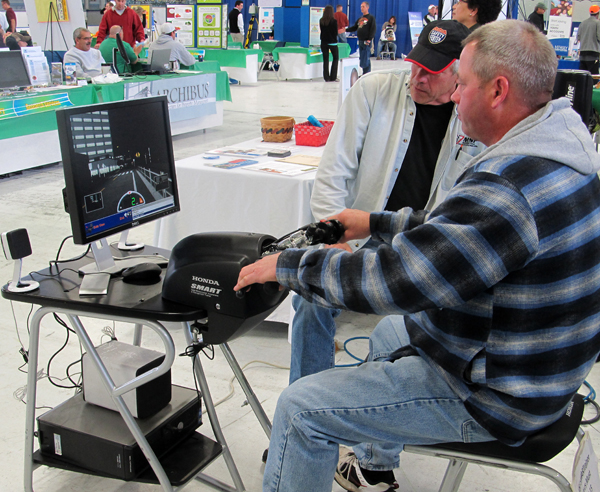
The Metro District held its Employee Days Oct. 7-8 at Aldrich Arena in Maplewood. Dan Erickson, Oakdale mechanic, tested his skills on a motorcycle simulator during the event. The simulator was one of the displays set up for the employees. Photo by Kent Barnard |
|
 |
|

|
 |
TABLE of CONTENTS
 |
October is Combined Charities Campaign month |
By Sue Roe
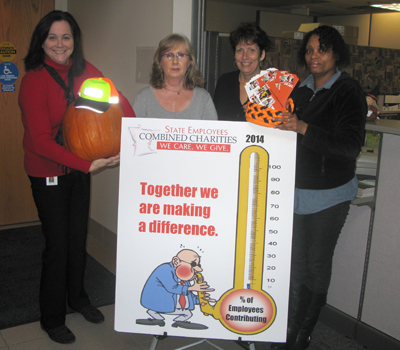
The Bridge Office’s Combined Charities campaign includes marking employee donations on this poster. From left are Lisa Gaughan, Betty Winter, Amy Zerwas and Stacy McKenzie. Zerwas is coordinating this year’s campaign. Once employees donate, they are entered into a drawing to win a pumpkin. Photo by Jim Pierce |
MnDOT employees can make a difference in the lives of others in need by participating in the annual Minnesota State Employees’ Combined Charities Campaign. Employees can donate to the charity or charities of their choice through the convenience of payroll deduction. The campaign runs throughout October.
The campaign has raised more than $20 million for Minnesota charities over the years. Last year, state employees pledged more than $882,000 for charities. This year, MnDOT’s goal is to raise $50,000 to contribute to the statewide goal of $1 million. Click here to donate.
“In order to continue making a difference in the lives of individuals affected by the work of the charities, it is vital for this year’s campaign to be a success,” said Commissioner Charlie Zelle. “MnDOT plays an important role in helping people whose lives are impacted by the campaign.”
The Combined Charities Campaign is planned and run each year by state employees. MnDOT district coordinators are: Karen Bohjanen, D1; Joe McKinnon, D2; JP Gillach, D3; Tammy Maijala, D4; Debbie Tlougan, D6; Rebecca Arndt, D7; Linda Vandendriessche, D8; Maureen Widmer, Metro; Amy Zerwas, Bridge Office; and Lorianna Yang and Nou Chang, Central Office.
Donations help various organizations throughout the state, including United Way, Community Shares organizations, arts funds and PeaceMaker Minnesota. For a complete list of charities by region go to the Combined Charities website.
“Any amount people can give, even if it’s $1 per pay period, will have a genuine impact on someone’s life,” said Zelle.
Amy Zerwas, campaign coordinator at the Bridge Office, said employees can also make a one-time donation or designate a specific amount that is only taken out a few weeks or half the year through payroll.
“Whatever an employee may want to pledge to a charity of their choice is easy to set up,” said Zerwas. “Hopefully with each office doing better than the year before, the statewide goal of a $1 million and MnDOT’s goal of $50,000 will be reached.”
|
 |
|

|
 |
TABLE of CONTENTS
 |
Ombudsman team evolves as caseloads increase |
By Jessica Etukudo, Office of Ombudsman
The Ombudsman Office continues its efforts to serve the citizens of Minnesota and MnDOT employees. As a neutral, informal and independent conflict resolution program, the Ombudsman Office serves as a resource for both the public and MnDOT to resolve transportation-related issues.
In the past year the office's caseload increased, resulting in some shifts in staffing. In addition, its efforts have been recognized in various forms, including being nominated for the Continuous Improvement Award.
Last October, International Conflict Resolution Day fell within Minnesota’s Conflict Resolution Week as proclaimed by Gov. Mark Dayton. The office participated in International Conflict Resolution day through its promotion of the positive role alternative conflict resolution processes play in daily life.
The office promoted new services, including “Advice/Consultation” sessions, which gives anyone involved in a conflict situation the opportunity to run ideas past an ombudsman and get feedback from a neutral perspective. Another service promoted was the “Heads- Up” proviso, which gives MnDOT districts the opportunity to involve the Ombudsman Office in the early stages of a potential conflict.

Conflict Resolution Day is set up to promote peaceful means of resolving conflict in all areas of life. |
The office also used Conflict Resolution Day to promote the passage of the Transportation Omnibus Bill which codified the Transportation Ombudsman into statute.
This year Minnesota's Conflict Resolution Week is October 13 – 19 and the international Conflict Resolution Day is Oct. 16. The focus of the day is to promote awareness of mediation, arbitration, conciliation and other creative peaceful means of resolving conflict in all areas of life.
The Ombudsman’s Office was nominated for the Governor’s Continuous Improvement Award for Achievement in streamlining office operations protocols to align with MnDOT’s “Wildly Important Goal” of enhancing financial effectiveness.
During the past six years, the Ombudsman Office has seen an increase in the amount of cases and a decrease in the amount of time it takes to resolve those cases and that trend has continued to prosper. The decrease in reduction in time can be tied to the office redefining its protocols and its overall evolution from its inception. The office increased its caseload by 18.5 per year. Meanwhile it had an overall reduction of 15 days fewer per year to resolve a case. Presently, the office has a total caseload of 77 complaints. Central Office has approximately 14 percent of those cases, Metro District has 45 percent, and the rest of the districts make up 36 percent of cases. Five percent of the cases are statewide.
The Ombudsman Office staff has also shifted. Marcell Walker has moved into the role of deputy ombudsman and is the team lead. Ben Lowndes joined the team over the summer as an assistant ombudsman and, recently, the office brought on Jessica Etukudo as another assistant ombudsman. The office plans to continue making progress, building and sustaining collaborative relationships, and educating MnDOT and the public on alternative dispute resolution practices. |
 |
|

|
 |
TABLE of CONTENTS
 |
Civil Rights adds assistant director to staff |
By Mary McFarland Brooks

Pictured with OCR Assistant Director Mary B. Schmidt (center) are Laura Wright, state program administrator, and Rajan Nayar, administrative assistant, both with the small business contracting unit. Photo by Mary McFarland Brooks |
Mary B. Schmidt joins MnDOT’s Office of Civil Rights as assistant director, where she will coordinate and supervise MnDOT’s statewide programs. Schmidt’s more specialized function is to provide oversight for the OCR’s small business contracting and contract compliance units.
“I am excited to have Mary join the OCR leadership team,” said Kim Collins, OCR director. "She has a background of diverse experiences and her talent will be a real asset in OCR’s efforts towards continuous improvement.”
Schmidt comes to MnDOT from the Minnesota Department of Employment and Economic Development, where she oversaw operations at metro-area workforce centers. She also developed interagency initiatives to improve access to workforce and education programs for Minnesotans lacking the skills to compete in the state’s labor market.
“I look forward to working with the OCR team, internal MnDOT offices, officials from cities and counties statewide and other stakeholder groups in the MnDOT contracting community,” said Schmidt. “I intend to improve our efficiencies and ensure that our project goal setting, contract clearances, project monitoring and training activities are administered appropriately. I see my role as helping each OCR staff member be his or her best.”
Prior to state employment, Schmidt served as vice president of the Minnesota Housing Partnership in St. Paul, a statewide nonprofit that assists communities with planning and building affordable housing. Schmidt also served as a social protection specialist at the World Bank in Washington, D.C, where she led teams working alongside government and non-governmental stakeholders in Eastern Europe, Central Asia and the Middle East to improve water quality, wastewater, roads, schools and other infrastructure and services essential to economic growth and poverty reduction.
Schmidt received a bachelor’s degree from the College of Saint Benedict, and a master’s degree from Georgetown University in Washington, D.C. She is originally from southeast Iowa.
Schmidt can be reached at mary.b.schmidt@state.mn.us and 651-366-3327. |
 |
|

|
 |
TABLE of CONTENTS
 |
Insurance enrollment opens for employees Oct. 31 to Nov. 13 |
By Sue Roe
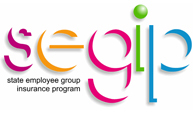
Open enrollment for State Employee Group Insurance program is Oct. 31 to Nov.13. |
Employees who want to make changes to their benefits can do so between Oct. 31 to Nov.13. Open enrollment meetings started this week throughout the state and will continue through Oct. 24.
Employees may attend any open enrollment meeting during October, even those scheduled at other agencies. Meeting times and locations can be found at the State Employee Group Insurance Program website.
Changes in this year’s plan include a $500 carryover for the pre-tax medical/dental expense accounts, less than a 2 percent increase in dental plan premiums, primary care clinic changes and a cost for the Advantage Health Plan single premium. Single insurance cost will be $26.26 per month. Family cost will be $179.18 per month.
This year’s open enrollment allows employees to change their medical insurance carriers and add or drop dependent or family coverage. Employees also may adjust coverage for long-term disability, child life insurance, flexible spending accounts, and the Manager’s Income Protection Plan.
Employees currently participating in the flexible spending accounts and pre-tax plans for medical, dental, dependent care and transit must re-enroll for 2015.
During open enrollment, employees also can sign up for a StayWell Health Assessment, which includes completing a personal health assessment and accepting a health coach call to receive $5 reduction in office visit copayments in 2015. Register for an account with StayWell now and complete the personal health assessment during the open enrollment period.
Connie Eystad, HR transaction benefits supervisor, said some benefits are not open every year. For example, dental benefits are open every other year; dental is not open for changes this year.
“It’s important that employees attend an open enrollment meeting to see what’s new and open for changes,” Eystad said. “We encourage everyone to read the emails the Human Resource benefits staff will send during the open enrollment period. These emails will have tips and reminders to help guide employees to a successful open enrollment period.”
Eystad also said employees will receive a SEGIP Report newsletter to their home addresses this week explaining the benefits open for enrollment.
For more information about open enrollment, contact Deborah Staples, 651-366-3405; Pam Horwath, 651-366-3376; or Connie Eystad, 651-366-3398. |
 |
|

|
 |
TABLE of CONTENTS
 |
What’s new on the web |
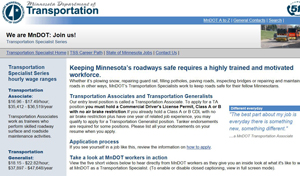
Check out the updated Jobs with MnDOT website. |
MnDOT Jobs
The MnDOT jobs website recently got a facelift, and is now reorganized and optimized for viewing on mobile devices. Job seekers can find current MnDOT vacancies and learn more about student worker and internship opportunities, road maintenance and construction opportunities, and the Graduate Engineer and Land Surveyor Trainee Program.
Check it out on A to Z under “Jobs with MnDOT” or at http://www.dot.state.mn.us/jobs/
New Library Materials posted on the web
New Library Materials are available at www.mndot.gov/library/newlibmat.html. This issue highlights MnDOT Library’s collection on books to improve interviewing skills, for both hiring managers and applicants.
New Library Materials is a compilation of new titles and other resources added to the library collection during the previous month. If you would like to be added to the distribution list, contact pamela.m.gonzalez@state.mn.us or 651-366-3749.
Previous editions of New Library Materials are archived and available at www.dot.state.mn.us/library/recacq-archive.html. For other information requests, contact the Library at 651-366-3791 or e-mail library.dot@state.mn.us, or send requests via the “Ask a Librarian” web page at www.dot.state.mn.us/library/asklibrarian.html. |
 |
|
| |
|



